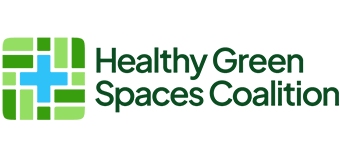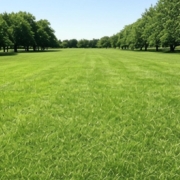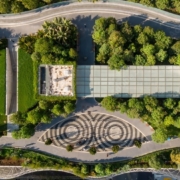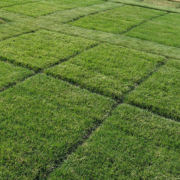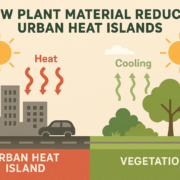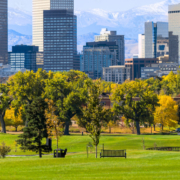The Hidden Cost of Turf Removal
The Hidden Cost of Turf Removal: Why Going Grass-Free Isn’t Always Greener
Turfgrass removal programs have gained traction in recent years as the need for water conservation has grown, especially in arid and drought-prone areas of the country. State agencies, utilities, and even homeowners’ associations encourage the replacement of traditional lawns with xeric landscapes, artificial turf, or gravel, framing it as a simple fix for reducing outdoor water use. And that’s the key word….simple. While we’d all like a simple solution to water resource challenges, reducing outdoor water use is far more complex than just removing one type of plant from the landscape. There are broader environmental and economic consequences and these are rarely discussed.
In reality, turfgrass—when properly selected and maintained—offers a range of ecosystem services that can be lost when it’s removed from landscapes. These include atmospheric cooling, carbon sequestration, air and water purification, and increased stormwater infiltration. In contrast, removing turf can lead to unintended negative consequences like increased energy costs for cooling structures, urban heat island intensification, reduced biodiversity, and little to no water savings if replacement landscapes are poorly designed or maintained.
There are hidden costs to turfgrass removal and a more nuanced approach is needed. Rather than advocating for turfgrass removal at all costs, the goal should be a balanced, evidence-based approach that both achieves water savings and preserves the beneficial role of turfgrasses in sustainable urban landscapes.
Costs and Replacement Challenges
In addition to promotion as a water-saving measure, turfgrass removal is often promoted as a cost-saving measure. However, the costs associated with removing and replacing turfgrass can be substantial. Direct costs include the physical removal of existing turfgrass, which can require heavy equipment or labor-intensive manual work, the disposal of related green waste, and the purchase and installation of replacement materials such as mulch, gravel, native and adapted plants, or artificial turf, not to mention the cost associated with changes to irrigation systems.
These expenses can easily exceed several thousand dollars for a typical residential yard. However, what is less frequently considered are the long-term maintenance costs of the replacement landscapes. Xeriscapes, for example, require ongoing weed control, pruning, re-mulching, and irrigation system modifications, especially during establishment periods and times of extreme heat or drought.
Choosing plants that are appropriate for xeriscapes is not necessarily an easy task either. There are several xeric plants, for example, that are well-adapted to drought conditions but do not use water efficiently (Tipton, 1994). In addition, some plants recommended for xeriscapes can become weedy or invasive if overwatered (Smith and St. Hilaire, 1999) and some of these plants have escaped from managed landscapes and are invasive species in California and the northwest (St. Hilaire et al., 2008).
Additional research has also shown that many low-water landscapes do not perform or function as they are meant to without proper design and sustained care. Poorly installed xeriscapes may result in soil erosion, weed infestations, and plant death. All of which can lead to replanting costs that offset any initial water savings (St. Hilaire et al., 2008; Braun et al., 2024).
In contrast, well-managed turfgrass systems, particularly those planted with drought-tolerant species, can provide long-term environmental and functional benefits with relatively predictable and moderate upkeep costs.
Energy for Cooling and Urban Heat Island Intensification
Turfgrass plays a significant role in moderating urban temperatures through the process of evapotranspiration and, to a lesser extent, shading of the soil surface—particularly when integrated with trees, shrubs, and taller vegetation. When turfgrass is removed and replaced with hardscape, gravel, or synthetic materials, ambient temperatures around buildings can increase and lead to increased use of and reliance on mechanical cooling systems.
This effect is well documented in urban climatology studies. For example, Shashua-Bar et al. (2009) found that vegetated surfaces, including turfgrass, significantly reduced surface and air temperatures in urban environments compared to non-vegetated alternatives. Further, they found that the combination of turfgrass and trees provided more cooling than either trees or turfgrass alone in the Negev Desert region. Turfgrass surfaces were also found to be only 1.6°C warmer than air temperature in College Station, TX as compared to synthetic turf (11°C warmer), granite (6.5°C warmer), and shredded hardwood mulch (8.8°C warmer) (Carvalho et al., 2021).
The implications for building energy use are considerable. Increasing vegetative cover around buildings can reduce summertime cooling energy use by 20–30% (Akbari et al., 2001). In contrast, removing vegetative groundcovers like turfgrass can lead to higher energy bills, especially in regions with hot, dry summers. This increase in cooling demand not only impacts household expenses but also contributes to higher greenhouse gas emissions through elevated electricity consumption.
The removal of turfgrass in favor of gravel, hardscape, or synthetic turf often leads to an increase in surface temperatures, contributing directly to the intensification of urban heat island effects. Natural turfgrasses cool the environment through evapotranspiration, but non-living alternatives absorb and re-radiate solar energy, significantly raising local temperatures.
Yilmaz et al. (2008), for example, found that asphalt and bare soil surfaces were 11.8°C and 5.3°C hotter during peak summer conditions, respectively, than turfgrass surfaces. Synthetic turf has also been shown to reach temperatures exceeding 60°C (140°F) under sunny conditions, creating intolerable conditions for people and pets while increasing heat stress on surrounding structures.
Vulnerable populations are disproportionately affected by urban heat island impacts including the elderly, low-income communities, and those without access to air conditioning. As cities grow hotter, though, the demand for mechanical cooling will increase, further straining energy grids and increasing greenhouse gas emissions. Related, Kenward et al. (2014) reported that urban areas in the U.S. are warming faster than their rural counterparts, largely due to increased impervious surface coverage and loss of vegetative cover.
Turf-covered areas also help buffer radiant heat from adjacent surfaces like sidewalks and walls, which reduces nighttime heat retention. And as cities seek to combat urban heat islands, removing turfgrass without considering its cooling benefits can result in negative energy and climate outcomes, reinforcing the importance of integrated and nuanced landscape planning.
Increased Infrastructure Costs
Turfgrass plays a vital role in stormwater management because it acts as a living sponge to facilitate infiltration, reduce surface runoff, and filter pollutants before they reach waterways. Its dense root systems and permeable soil structure allows rainfall and irrigation to soak into the ground, reducing the burden on urban stormwater systems.
In contrast, the replacement of turfgrass areas with impervious surfaces like gravel, compacted decomposed granite, or synthetic turf can significantly increase runoff volumes, especially during intense precipitation events. And according to the EPA WaterSense™ program (2023), landscapes lacking vegetation and infiltration capacity contribute to increased flooding, erosion, and contamination of surface waters.
Many xeriscaped landscapes—especially those that are poorly implemented—lack sufficient plant coverage or soil capacity to support stormwater infiltration. As a result, stormwater flows over these surfaces and picks up sediment, nutrients, pesticides, and heavy metals that may then be washed into municipal storm drains and water bodies.
This not only leads to higher pollutant loading but also increases the cost of stormwater treatment and infrastructure maintenance (Hellman et al., 2018). Furthermore, the loss of turf can reduce the filtering capacity of urban green spaces, weakening the ecosystem services tied to water purification and groundwater recharge that turfgrasses provide.
Increased runoff from landscapes that lack the capacity to slow that runoff forces cities to invest in larger, more complex stormwater infrastructure, including retention basins, bioswales, and underground detention systems. These systems are expensive to construct and maintain, and they often do not provide the same multi-functional benefits as healthy vegetated areas.
Conclusion
While turfgrass removal is often pursued in the name of water conservation, it is not without its trade-offs. Eliminating turfgrass from the landscape, for example, can lead to increased energy use for cooling, hotter urban environments, reduced air and water quality, and even higher long-term maintenance and infrastructure costs.
These unintended, negative consequences demonstrate the importance of a balanced and evidence-based approach. Cities and homeowners should focus on promoting resource-efficient turfgrass varieties, appropriate landscape designs, and the use of smart irrigation technologies to optimize water use while preserving the essential ecosystem services that living landscapes (that include turfgrass) provide.
The key is to reimagine the role of turfgrasses in modern, sustainable communities. When thoughtfully chosen and managed, turfgrasses can continue to provide cooling, erosion control, carbon sequestration, and recreational value without excessive water consumption. In fact, a truly greener future may still include green grass—especially when that grass is matched to climate conditions, irrigated efficiently, and integrated into multifunctional, climate-resilient landscapes.
References
Akbari, H., M. Pomerantz and H. Taha. 2001. Cool surfaces and shade trees to reduce energy use and improve air quality in urban areas. Solar Energy 70(3), 295–310. https://doi.org/10.1016/S0038-092X(00)00089-X.
Braun, R.C., P. Mandal, E. Nwachukwu and A. Stanton. 2024. The role of turfgrasses in environmental protection and their benefits to humans: Thirty years later. Crop Science 64:2909-2944.
Carvalho, H.D., B. Chang, K.J. McInnes, J.L. Heilman, B. Wherley and J.A. Aitkenhead-Peterson. 2021. Energy balance and temperature regime of different materials used in urban landscaping. Urban Climate 37:100854. https://doi.org/10.1016/j.uclim.2021.100854.
EPA WaterSense. 2023. Outdoor water use in the United States. U.S. Environmental Protection Agency.
Hellman, K., J. Wagner, D. Lass, K. Korfmacher and B.G. Hanna. 2018. Estimating the economic impact of stormwater runoff in the Allen Creek watershed. Ecological Economics 145: 420-429.
Kenward, A., D. Yawitz, T. Sanford and R. Wang. 2014. Summer in the City: Hot and Getting Hotter. Climate Central. Princeton, NJ.
Smith, C. and R. St Hilaire. 1999. Xeriscaping in the urban environment. New Mexico Journal of Science 1999: 241-241.
Spronken-Smith, R.A. and T.R. Oke. 1998. The thermal regime of urban parks in two cities with different summer climates. International Journal of Remote Sensing 19(11):2085–2104. https://doi.org/10.1080/014311698214884.
St. Hilaire, R., M.A. Arnold, D.C. Wilkerson, D.A. Devitt, B.H. Hurd, B.J. Lesikar, B. J., V.I. Lohr, C. Martin, G.V. McDonald, R.L. Morris, D.R. Pittenger, D.A. Shaw and D.F. Zoldoske. 2008. Efficient water use in residential urban landscapes. HortScience 43(7):2081-2092.
Tipton, J.L. 1994. Relative drought resistance among selected southwestern landscape plants. Arboriculture and Urban Forestry 20(3):150-155.
Yilmaz, S., T. Süleyman, M.A. Irmak and H. Yilmaz. 2007. Determination of climatic differences in three different land uses in the city of Erzurum, Turkey. Building and Environment 42(2):1604-1612.
